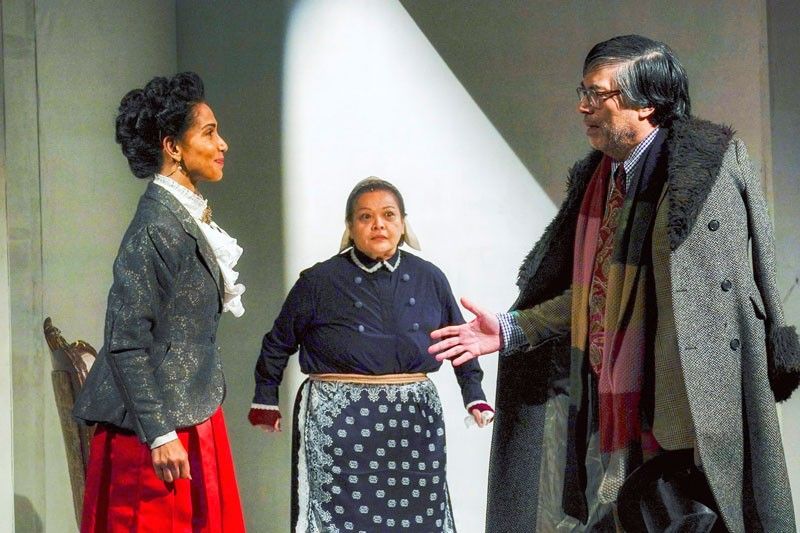Goodbye, Dolly

As my mother-in-law likes to point out, the Philippines is the only country in the world that still does not allow divorce. For whatever reason — insecure male politicians in power, the Catholic Church, attachment to one’s children — marriage isn’t something you just walk away from.
Except Nora Helmer does in Henrik Ibsen’s 1879 play, A Doll’s House. Set in male-dominated Norwegian society, that play, in which Nora literally walks out her husband’s door, has since been read as a feminist manifesto.
Over a century later comes a sequel, Lucas Hnath’s 2017 production A Doll’s House, Part 2, a prismatic take on what’s changed, and what hasn’t, since then. The sequel imagines what happens to Nora 15 years after the original Ibsen play. And Red Turnip Theater, returning for its fifth season, presents us with a close-quarters, intimate look in this 90-minute four-hander.
It’s the kind of play that makes some women go “Hmmm” and many men squirm in their seats. (Fact: at least one male patron in our audience experienced stomach pains after watching the drama. We don’t know if this was a direct side effect.) Some may call it polarizing — the debates about class, gender equality, divorce, and the role of men and women in society that ensue. Others just call it good theater.
In the hands of first-time director Cris Villonco, the actors inhabit a little corner of vertical white space. Furniture is sparse (two chairs). The four characters’ names are lit up in blank, Dogma-style letters to introduce them as they enter the stage. It’s very Scandinavian.
Nora (Menchu Lauchengco-Yulo) returns to the house of her husband Torvald (Carlitos Siguion-Reyna), now a successful woman. She’s well-off, well-dressed, having carved out a life for herself that’s separate from her husband, but also her children, now grown up. What’s Nora been up to since closing the door on marriage? She writes books, mostly about herself and her experience of, well, closing the door on marriage. They’re eagerly received by women who are also discontent in their marriages, and they sell quite well. Of course, she must write under a pseudonym, which is ironic: claiming an identity while hiding behind another.
She is received warily in Torvald’s sitting room by Anne Marie (Sheila Francisco), Nora’s former housekeeper and nanny to her children. We soon learn why. It seems those divorce papers never got filed. Torvald, for reasons that eventually become clear, did not legally divorce Nora — and as she points out, society makes it much harder for women to show grounds for divorce — so she is, essentially, there to ask a favor. And it is her way of arriving at a truth that fits her life best that forms the heart of Hnath’s play.
Also making Anne Marie wary is the fact that Nora ditched her children in a bid for independence. Absent from Ibsen’s original play was a look at the plight of nannies, housekeepers and — in a more modern context — OFWs. Anne Marie’s ironic eye-rolling as she endures Nora’s Ted Talk-like lecture on the benefits of freedom suggests how selfish her employer’s trajectory has been; Nora, after all, never looked after her own children. (In Ibsen’s play, they don’t even have names.) It’s sly of Hnath to introduce social class in a manner that was absent from Ibsen’s original.
Here in Torvald’s home, though, Nora is forced to confront her now-grown daughter Emmy (Rachel Coates) and ask her for a favor as well.
The cast entwine themselves deeply in the rigors of the text. Lauchengco-Yulo dominates the stage in her 19th-century finery, striding around the stage’s two chairs; but Francisco, as Anne Marie, is a perfect foil, and nearly steals each scene. Noted director Siguion-Reyna plays Torvald as fumbling and exasperated as ever — a weak man at first, but one who reveals unexpected depths and draws our sympathy. And Coates is almost eerie as Emmy, an inscrutable millennial dressed in her modern Doc Martens and presenting marriage in a light that contradicts the easy feminist theories. “Are we just nomads?” Emmy asks at one point, when Nora insists love should exist without any lifelong bonding or contracts. What, then, of family?
While Villonco and Red Turnip didn’t set out to stage a polarizing play, in the best way, Doll’s House, Part 2 harks back to the theater company’s beginnings in shows like Cock: sparse productions focusing on four characters and strong text. The director says they’ve found a business model — houses seating 80 to 120 people, one-act 90-minute plays, small casts and an intimate stage — that will hopefully better sustain Red Turnip for more seasons.
Villonco uses her small vertical stage well: it’s claustrophobic at times (all four characters never occupy it together), but relying on only two chairs is ideal in showing the characters at cross-purposes — whether faced in opposite directions, circling around one another, or dragging those chairs to far corners of the stage.
It’s at times a suffocating experience, being up close to this quartet of characters — you can see why Sartre chose to call his play about Hell No Exit. The experience has us leaving the theater shocked and disturbed, but also with our truths tested.
Cris Villonco enters the ‘Doll’s house’

Cris Villonco
Is there a monologue or line in Hnath’s play that sticks out for you?
Cris Villonco: We all know there’s an adjustment period in the first years of marriage; there’s another layer of getting to know each other. So when Nora goes into her monologue about marriage being a binding contract, that hit me. When she starts talking about how we say “I choose you, I choose you forever!” But who is this “you” you’re choosing, because this person can change five or 10 years from now, and it’s not really the person that you chose from the beginning, but the evolution of that person.
There’s also the wooing part — the whole idea that you’re wooing someone in the beginning, putting your best foot forward, but what if that best foot forward is no longer there? What if you’re really seeing the real side of a person, no longer the best side, but the worst?
Have you noticed a polarized reaction among male and female viewers? If so, what’s that about?
It’s very interesting, some men actually agree with, especially, that monologue. Some men have thanked me for opening up, I don’t know, a can of worms or a Pandora’s box — something for them to discuss. Others have told me, “Wow, this is a lot to take in.” Maybe it hits people in different ways, but I know it definitely starts a discussion between people, whether or not they’re married.
There’s a message too about levels of society, the OFW situation with Anne Marie. How does it resonate here?
This gets me every time: when I watch this interaction between Nora and Anne Marie, I tear up, because, yes, certain people have choices they can make and that they can pursue, and others don’t. And there’s a certain type of gratitude that is forgotten. That hits me as well.
Emmy seems somewhat conventional in her views on marriage.
Nowadays, we really do romanticize proposals, big proposals and big weddings. I’m guilty of that. I think it’s a millennial way to present, whether or not on social media, how happy you are and how things are. And I’m very happy for those who are, but there’s also those that are not, and mainly put on a façade of what marriage truly is.
With Emmy, it’s also something about her wanting to be loved and all of that. I think it’s a reaction to her mother, who’s definitely gone the opposite way. But it’s a very young take on marriage and I wanted to show that, in an innocent light.
It’s like Red Turnip has come full circle: four characters and a sparse setting. Do you think this business model will be good going forward?
There’s still a need for straight plays among theater-goers. We need to increase our marketing and publicity. I think we know now that a good 80 to 120 people is enough for each performance. Also I’m noticing a trend, even on Broadway, that everyone is working towards just 90-minute shows, particularly with straight plays. I think that will be the trend because, with the day and age, the attention span is much shorter.
* * *
A Doll’s House, Part 2 runs weekends until Oct. 7 at the Zobel De Ayala Recital Hall, Maybank Performing Arts Theater, BGC Arts Center. Tickets available through TicketWorld (891-9999 or www.ticketworld.com.ph) or Red Turnip Theater (redturniptheater@gmail.com or https://www.facebook.com/RedTurnipTheater). Complete show schedules are on the Red Turnip Facebook Page.



















